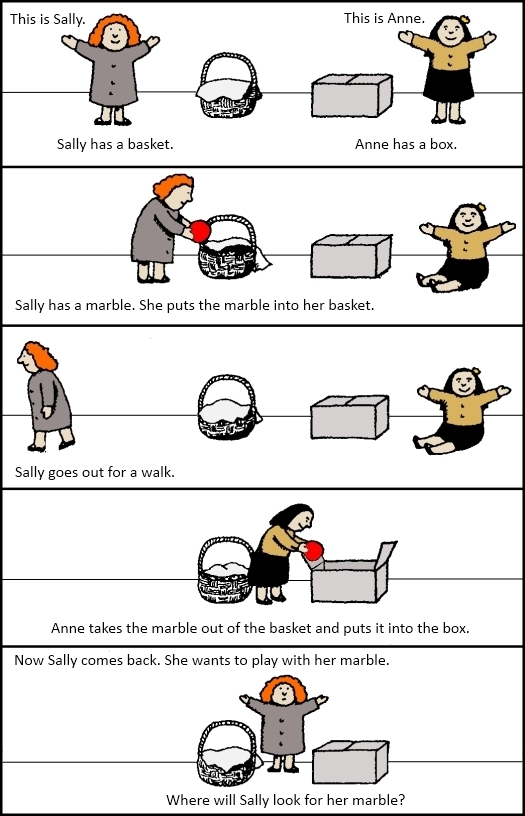In ABA, we’re continually seeking ways to enhance the lives of individuals with learning and behavior challenges. Among the concepts and strategies at our disposal, Theory of Mind (ToM) and Perspective Taking stand out for their profound impact on social interactions and personal development.
This post delves into these concepts, exploring their significance and the ways in which they can be nurtured through ABA.
Understanding Theory of Mind & Why It’s Important
Theory of Mind sounds like it belongs in a sci-fi novel, but it’s actually a critical aspect of human psychology. It refers to the ability to understand that others have thoughts, feelings, and perspectives that are different from our own. This skill typically begins to develop around age 4 in neurotypical children but can present challenges for those with ASD.
An example of Theory of Mind (ToM) in everyday life could be understanding and acknowledging differing food preferences between individuals. For instance, you might have a deep love for spicy food, enjoying the sensation and the flavors that come with it. However, you recognize that your friend doesn’t share this preference; they might find spicy food overwhelming or even unpleasant.
This awareness allows you to suggest a restaurant that offers a variety of options catering to both your love for spice and your friend’s milder palate when planning a dinner outing. This example illustrates the capacity to understand that others have thoughts, feelings, and preferences that are distinct from our own, a fundamental aspect of Theory of Mind.
For our learners, grasping the nuances of ToM doesn’t always come naturally, making social interactions more challenging. Recognizing emotions, understanding jokes, or grasping the concept of deception requires a developed Theory of Mind. It’s not just about knowing others have different thoughts, but being able to predict and react to those thoughts appropriately.

The Role of Perspective Taking in ABA
Perspective Taking is closely linked to ToM; it’s essentially putting Theory of Mind into action. It’s the skill that allows us to step into someone else’s shoes, see the world from their viewpoint, and adjust our behavior accordingly.
For ABA practitioners and parents, teaching perspective-taking helps improve social interactions and emotional understanding for individuals with learning and behavior challenges.
Through various interventions, ABA seeks to build these skills, emphasizing the importance of understanding others to navigate the social world effectively. Whether it’s through direct instruction or naturalistic teaching opportunities, the goal is the same: to foster a deeper connection with the world around them. One step in this process is teaching our learners to understand emotions.
Theory of Mind Test
An important developmental milestone in this area is the ability to pass the “Sally-Anne Test,” a psychological assessment designed to measure a student’s social-cognitive ability to attribute false beliefs to others. This test involves a simple story where two characters, Sally and Anne, are involved in a scenario where Sally places an object in a location and leaves the room. While she is away, Anne moves the object to a different location.

The key question asked of the test participant is where Sally will look for the object upon her return. Successfully predicting that Sally will look in the original place (not knowing it was moved) indicates an understanding that others can hold beliefs that are different from reality.
This test, among others, serves as a foundational tool in assessing Theory of Mind capabilities, providing insights into the cognitive development of children and the social challenges faced by individuals with learning and behavior difficulties.

Strategies to Enhance Theory of Mind & Perspective Taking through ABA
Direct Teaching
One approach is to teach perspective-taking skills directly. This might involve breaking down social interactions into manageable parts, using role-play to practice different scenarios, or explicitly teaching the identification of emotions in others.
Video Modeling
Another effective tool is video modeling, where individuals watch videos demonstrating specific social situations. This method allows learners to observe, interpret, and eventually imitate the behaviors and thought processes of others.
Social Narratives
Social narratives are typically brief, hand-written stories or comic strip conversations designed to convey social cues, acceptable behaviors, and the thoughts and feelings of others in specific situations. They are visual and offer a structured way to present information. They can be personalized to address each individual’s unique needs.
Naturalistic Teaching Opportunities
Incorporating lessons into everyday activities provides a practical and relatable context for learning. This method emphasizes the spontaneous application of perspective-taking skills in real-life situations, reinforced by positive feedback and reinforcement.
Challenges & Considerations of Theory of Mind & Perspective Taking in ABA
While these strategies offer a pathway to improved social understanding, it’s crucial to recognize the diversity within each learner. Each individual’s strengths, weaknesses, and learning styles must be considered when designing interventions. Flexibility and patience are key, as progress may be gradual and non-linear.
Fostering Theory of Mind and Perspective Taking in students is both challenging and rewarding. As ABA professionals and parents, our role is to guide, support, and celebrate each step forward, no matter how small. By understanding and addressing these areas, we can unlock a world of deeper connections and enriched social experiences for those we serve.



Can you teach theory of mind to adults
I don’t see why not!
looking for a curriculum and protocol and materials for teaching theory of mind through ABA with a high functioning 8 year old
Try this one: https://www.amazon.com/Teaching-Children-Autism-Mind-Read-Workbook/dp/0470093242/ref=sr_1_1?crid=NQJ503YC4NOF&keywords=theory+of+mind+workbook&qid=1652915873&s=books&sprefix=theory+of+mind+workbook%2Cstripbooks-intl-ship%2C134&sr=1-1